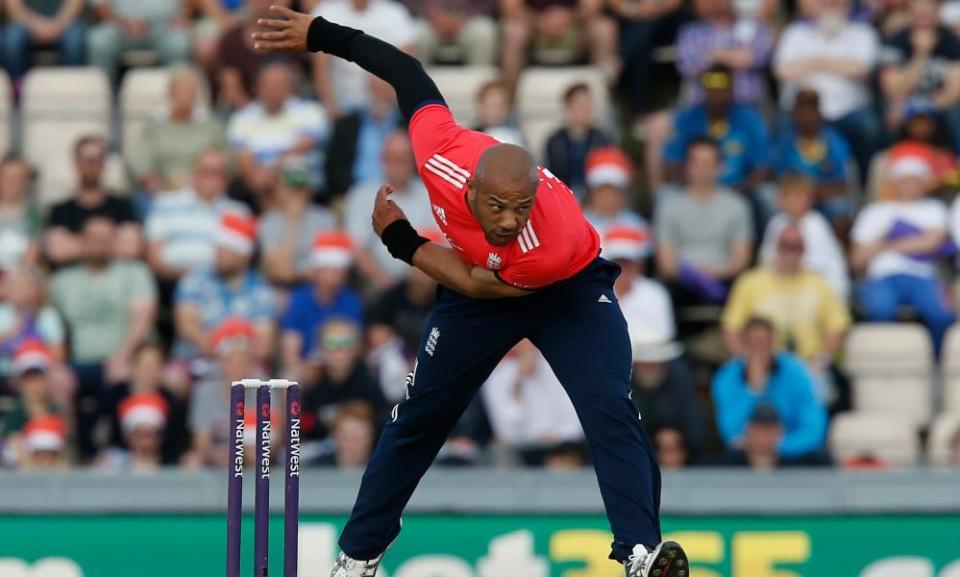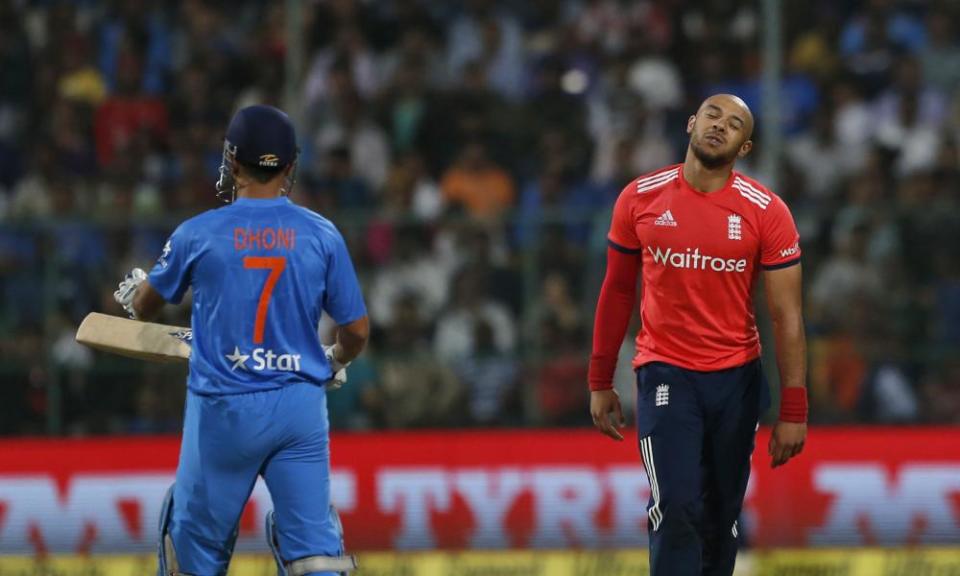Tymal Mills: what makes a player with no Tests or ODIs worth £1.4m in IPL? | Vic Marks

The 21st-century cricketer is so much better at “taking the positives” out of a seemingly bleak situation than predecessors were. This week for Tymal Mills, currently in Dubai playing for the Quetta Gladiators alongside Kevin Pietersen in the Pakistan Super League against players such as Chris Gayle and Kumar Sangakkara, every cloud really does seem to have a silver lining.
Two years ago Mills was diagnosed with a congenital back condition: his spinal cord and his vertebrae are too close together, meaning the former can become seriously aggravated. The experts decided that bowling fast over long periods of time was a risk too far.
Mills was 22; he had already demonstrated that he could propel the ball with his left arm at 90mph or more. There had been a buzz around the counties and among the England hierarchy. Technically Mills seemed equipped to excel in all forms of the game since extreme pace can be deadly whether the ball is white or red. But now he was consigned to just one form of the game, T20, which required him – on a good day – to bowl no more than 24 balls in an innings.
Last Monday the silver lining was dazzling. At the Indian Premier League auction there was a bidding war for Mills, who has played four T20 games for England, taking three wickets, scoring no runs (after a solitary two‑ball innings) and holding one catch. In the end he was bought by Royal Challengers Bangalore for £1.4m, a staggering 24 times his base price.
Mills is bright and personable – he once started a journalism course, though he now seems to have found a much swifter way to make money – and he recognises that the limitations imposed by his body have, curiously, enhanced his career. “My back injury could have been the best thing that’s happened to me,” he said while still acclimatising to his new status, “because it’s changed all my focus to playing T20 and it’s probably accelerated my development in that form of the game – without having to focus on the other formats.”
Even so, the price for such an unproven cricketer is astonishing and hard to explain. It is too simple to suggest that the astronomical fee that Mills commanded can be attributed to the adrenaline of the auction rooms. In April the 10th IPL season gets under way; the protagonists have surely been around long enough to be business-like in their approach. Yet this obviously does not rule out a bidding frenzy (in this case Royal Challengers Bangalore were joined by Kolkata Knight Riders in the final stages of the pursuit of Mills).

So what were his attractions to the IPL coaches? First – mundanely – there is his availability. Of all the English players in the auction he was the only one who could play the entire IPL season (some, such as Ben Stokes, have to return by 14 May for a training camp; Eoin Morgan and others must be back by 1 May for the Ireland ODI series – the IPL final is on 21 May).
Mills is a bowler and they tend to be more in demand. There seem to be plenty of batsmen who can heave the ball over the disappointingly short boundaries of the IPL. Even better, Mills is a left-handed pace bowler and that angle of delivery is often reckoned to be more effective in this format.
Tom Moody, the coach of Hyderabad Sunrisers, certainly believes in this theory and the Australian’s side won the IPL last year. He signed the relatively unknown Bangladesh left-armer, Mustafizur Rahman, to join the veteran Indian Ashish Nehra, and Moody’s faith was justified. (This year it will be fascinating to see how two Afghanistan cricketers, Rashid Khan, the precocious teenage wrist-spinner, and the veteran Mohammad Nabi fare for the Sunrisers.)
Moreover, the late withdrawal of the Australian Mitchell Starc, who has performed well for Bangalore in the past, was timely for Mills. Starc is one of the best left-armers in the world and he took the long-term view: that he needed to refresh mentally and physically for the challenges ahead – and, no doubt, this was a decision greeted with glee by Cricket Australia as well as Mills.
Then there is the odd key connection. This winter Mills played briefly for Brisbane Heat in the Big Bash, impressing not just with his pace but the cleverness of his slower ball variations. Coaching there was Daniel Vettori, who also happens to be the coach of the Royal Challengers Bangalore. The New Zealander must have been as captivated by Mills’ attitude as his bowling to justify that fee.
Thus a 21st-century, globe-trotting career is on the horizon for Mills with the Gladiators, the Heat, the Sharks, maybe the Vikings, most lucratively the Royal Challengers and – just occasionally – with England.

 Yahoo Sport
Yahoo Sport 





































